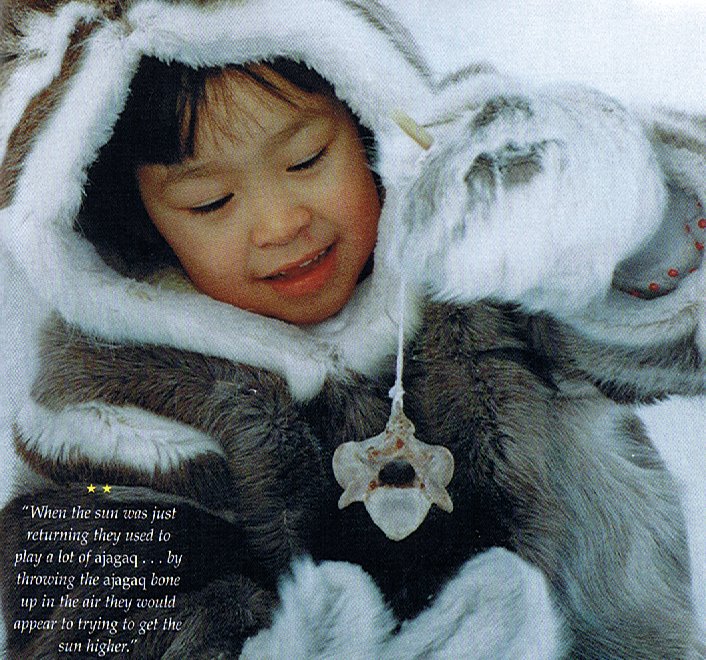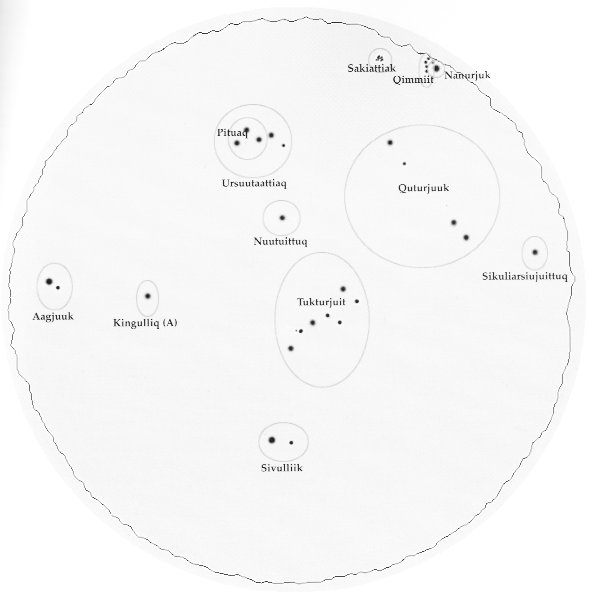|
4. For people living in the tropics it is natural to perceive there are 2 'years' in a year, because Sun is crossing above twice in a year. For people living in the polar area the perspective is quite different, the idea of daytime disappears into summer, blends into a single entity which comes only once in a year. In Cradle of the Cat there are descriptions which are relevant for the current discussion: ... string games could be resumed after it was clear that the Sun had managed to leave the horizon and was rapidly gaining in altitude: 'Before the sun starts to leave the horizon ... when it shows only on the horizon, ... then string games were no longer allowed as they might lacerate the sun. Once the sun had started to go higher and could be seen in its entirety, string games could be resumed, if one so wished. So the restriction on playing string games was only applicable during the period between the sun's return and its rising fully above the horizon ... Could strings, as for instance in string games (kaikai), indicate a kind of intercourse, perhaps in form of rain? There are strings in the Lyra constellation and also in Gemini. ... Now the deluge was caused by the male waters from the sky meeting the female waters which issued forth from the ground. The holes in the sky by which the upper waters escaped were made by God when he removed stars out of the constellation of the Pleiades; and in order to stop this torrent of rain, God had afterwards to bung up the two holes with a couple of stars borrowed from the constellation of the Bear. That is why the Bear runs after the Pleiades to this day; she wants her children back, but she will never get them till after the Last Day. To continue with the polar view: ... I knew of two men who lived in another settlement on the Noatak river. They did not believe in the spirit of the string figures, but said they originated from two stars, agguk, which are visible only when the sun has returned after the winter night. One of these men was inside a dance-house when a flood of mist poured in ... His two companions rapidly made and unmade the figure 'Two Labrets', an action intended to drive away the spirit of the string figures, uttering the usual formula ... but the mist kept pouring in ... ... Again, in a diary entry dated 18 December 1913 Jenness notes the same Alak telling him that 'they never played cat's cradles while two stars called agruk were visible, just before the long days of summer... They played other games then, like whizzer [a noise maker] ... ... Alak's comments indicate that, for the Noatak area at least, the appearance of Aagjuuk, rather than the Sun, signalled the end of the string-game season. And the opinion ... that string figures came from, and are therefore related to, Aagjuuk may have given rise to the prohibition against playing them after the solstice appearance of these stars. It is also possible that the string game mentioned by Alak - 'Two Labrets' - rapidly made and unmade in an attempt to drive off the 'string figure spirit', was intended to symbolize Aagjuuk's two stars and so confound the constellation with its own likeness or spirit. ... Etalook refers to the 'aagruuk' as 'labrets' (the circular lower-lip ornaments of some Western Arctic Eskimo groups, certainly evoke an astral image if we recall that early Inuit graphic representations of stars were usually circular ...) giving them, it seems, an alternate name, ayaqhaagnailak, 'they prohibit the playing of string games': They are the ones that discourage playing a string game... That's what they're called, ayaqhaagnailak, those two stars... When the two stars come out where is no daylight, people are advised not to play a string game then, but with hii, hii, hii... toy noisemakers of wood or bone and braided sinew ... A game which was allowed to play was ajagaq:  The text says: "When the sun was just returning they used to play a lot of ajagaq ... by throwing the ajagaq bone up in the air they would appear to be trying to get the sun higher." In spring it is important to 'get him up' - it is the season of procreation. Arctic Sky has a picture of the constellations which can be seen in the morning sky at winter solstice: 
I think the Polynesians were well aware of these facts, that there was a pair of 'eyes' high up in the north which was said to announce the return of Sun at winter solstice. But on Easter Island another pair of stars had to be chosen for this purpose because there winter solstice came half a year later. |